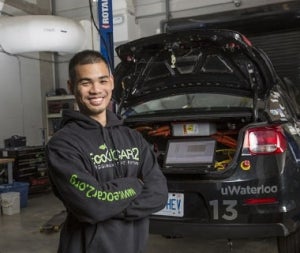
Student team works on next generation smart car
University of Waterloo engineering students hope to build a smart vehicle that understands and adapts to drivers’ habits

University of Waterloo engineering students hope to build a smart vehicle that understands and adapts to drivers’ habits
By Jae Doncillo Communications and Public AffairsImagine a car that could actually get to know you. Can’t picture it? Mechanical engineering student Kelvin Law is working to change that.
“Nowadays, some cars have sports and eco modes, but that’s still just two options. Imagine a car that optimizes itself for each unique driver,” says Law, a graduate student in the Department of Mechanical Engineering. “With this smart vehicle, you would have a smartphone app to log all your driving habits - how much you drive, how aggressive you are – and it would optimize the driving experience for you.”
 Its called the Adaptive Vehicle Control Strategy project and its part of the work Law and physics student, Brandon Walton, are leading on the University of Waterloo Alternative Fuels Team (UWAFT). The project is part of the team’s move to broaden its scope to improve all aspects of cars – not just alternative fuels.
Its called the Adaptive Vehicle Control Strategy project and its part of the work Law and physics student, Brandon Walton, are leading on the University of Waterloo Alternative Fuels Team (UWAFT). The project is part of the team’s move to broaden its scope to improve all aspects of cars – not just alternative fuels.
The technology combines a smartphone app with an integrated touchscreen computer in the car, says Law. As the driver operates the vehicle, the computer records data ranging from pedal position to driving speed and range, which gets stored on the smartphone app. The next time the driver starts up the car, the app feeds the recorded driving habit data back into the car’s computer, and the computer adjusts the car accordingly for an optimal driving experience.
A conservative driver will get optimization for fuel efficiency while the car will adapt for maximum performance for the more assertive driver, says Law.
The feature is not only an advantage in future competitions it could have huge implications for the industry as a whole, says Law. The ultimate goal is to deploy the Adaptive Vehicle Control Strategy system across all vehicles as a standard so you can jump into any vehicle and it will adjust itself to the driver’s habits.
Hands-on experience
“UWAFT is the only student team that gets to build full-size road-legal vehicles. They’re actual vehicles that we drive on the streets regularly; whether it is an on-road test we’re conducting or just going down the street to get parts, ” says Law. “We’re re-engineering and building a real car.
“These are workplace skills you learn from being on UWAFT so that when you enter the workforce with major automotive manufacturers and suppliers such as GM or Tesla, you’re that much more prepared because you’ve already built a car.”
The student team is currently competing in EcoCAR2, an engineering competition that challenges 15 universities across North America to reduce the environmental impact of a Chevrolet Malibu without compromising performance and safety. UWAFT placed third in Year 1 of the EcoCAR2 design competition. In 2005, UWAFT placed first in the ChallengeX competition with the first student-built road-worthy hydrogen fuel cell vehicle.

Read more
3D printing technology is perfect fit with new Waterloo Institute for Sustainable Aeronautics

Read more
Waterloo lab helps fill industry demand for additive manufacturing skills

Read more
Combining machine learning techniques with real-world scenarios to combat forest fires
The University of Waterloo acknowledges that much of our work takes place on the traditional territory of the Neutral, Anishinaabeg, and Haudenosaunee peoples. Our main campus is situated on the Haldimand Tract, the land granted to the Six Nations that includes six miles on each side of the Grand River. Our active work toward reconciliation takes place across our campuses through research, learning, teaching, and community building, and is co-ordinated within the Office of Indigenous Relations.